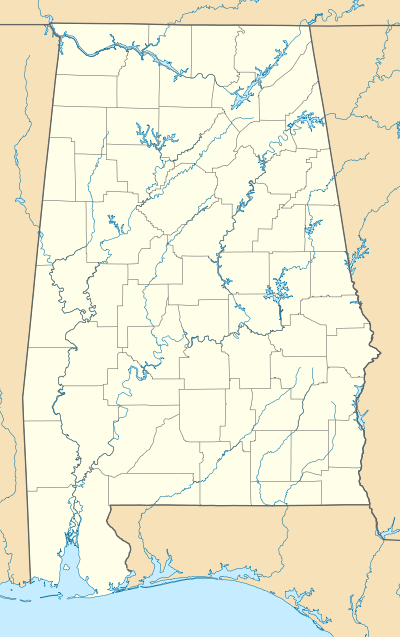Fort Decatur (Alabama)
Fort Decatur was an earthen fort established in March 1814 on the banks of the Tallapoosa River. The fort was located on the east bank of the Tallapoosa River, near the modern community of Milstead.[1] Fort Decatur was also located near the Creek town of Tukabatchee. It was most likely named for Stephen Decatur.[2]

Colonel Homer Milton, the commanding officer of the 3rd U.S. Infantry, ordered the construction of Fort Decatur and Fort Burrows in March 1814. Fort Burrows was located across the Tallapoosa River from Fort Decatur. The 7th North Carolina Militia was garrisoned at Fort Burrows and Fort Decatur.[3] Fort Decatur was planned to supply General Andrew Jackson in his march from Fort Williams to Hickory Ground, but flooding prevented the supplies from arriving.[4] After the Battle of Horseshoe Bend, Georgia and South Carolina troops under the command of Major General Thomas Pinckney marched from Fort Decatur to Fort Jackson.[5]
In 1815, President James Madison appointed Colonel John Sevier to the United States Boundary Commission to survey the boundary between the United States and the Creek Nation. The Commission was headquartered at Fort Decatur. On September 24, 1815, Sevier died and was buried at Fort Decatur. Sevier's remains were reinterred at the Knox County Courthouse in Knoxville on June 15, 1889.[6]
Today, the fort site is marked by a historical marker that was placed by the Alabama Anthropological Society in 1931. The remains of the fort on located on Auburn University's E.V. Smith Research Center.[2]
A post office operated under the name Fort Decatur from 1839 to 1859.[7]
References
- Harris, W. Stuart (1977). Dead Towns of Alabama. Tuscaloosa, Alabama: University of Alabama Press. p. 40. ISBN 0-8173-1125-4.
- Mike Bunn; Clay Williams (1 July 2008). Battle for the Southern Frontier: The Creek War and the War of 1812. Arcadia Publishing Incorporated. p. 59. ISBN 978-1-62584-381-4.
- Goss, Bill. "Early Forts Stand Stalwart". The Wetumpka Herald. Retrieved 3 April 2020.
- Bud Hannings (3 September 2012). The War of 1812: A Complete Chronology with Biographies of 63 General Officers. McFarland. p. 205. ISBN 978-0-7864-6385-5.
- William Garrott Brown; Albert James Pickett (1900). ...A History of Alabama, for Use in Schools: Based as to Its Earlier Parts on the Work of Albert J. Pickett. University Publishing Company. pp. 122.
- Samuel Cole Williams (1924). History of the Lost State of Franklin ... Watauga Press. p. 284.
- "Macon County". Jim Forte Postal History. Retrieved 3 April 2020.